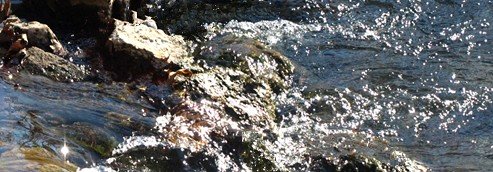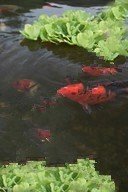Tips for Over Wintering Koi

Properly over wintering koi is important for fish health and survival in severe climates. Winter, as you know, brings harsh conditions, cold temperatures and ice to backyard garden ponds in some areas of the world. Read further for important tips on protecting your valuable fish.
If you live in a tropical area or where freezing is rare wintering koi is not a major concern. The maintenance involving your fish may not change much all year. In cooler areas where water temperatures usually drop below 45 degrees, there are several things you need to be prepared for. An example of something sometimes overlooked, be prepared to switch from a high protein summer koi food to wheat germ as temperatures start to drop in fall. By the time temperatures reach winter levels the switch should have been completed.
Philosophy of Backyard Garden Ponds In Cold Regions
In years past, the thinking was to allow your wintering coi to survive on their own without much assistance from us, except breaking the ice. However, that is no longer the case. Studies reveal that we should provide some degree of cold while removing winter's harshness.
Here's Why
Koi are believed to benefit from a slowed metabolism brought on by cooling water and less daylight. It resets their internal chemistry and defines a clear period for spawning as water temperatures and daylight increase in spring. Water kept at summer temperatures all year can play havoc on the koi's chemistry that triggers spawning.
Preparing Backyard Garden Ponds for Wintering koi
Besides water temperature, the most important consideration is the depth of your pond. If your pond typically freezes and your pond is shallower than 18 inches, you will have no choice but to heat the water. The shallower the pond the more important it is to keep the water open.
Clean all debris from the bottom of the pond, such as leaves or other material that could consume oxygen as they deteriorate should the pond freeze over unexpectedly.
Remove all plants from the water that cannot over winter in the pond. Some plants may be moved inside while other must be discarded.
Raise any pumps off the bottom so cold water is not circulated on the bottom where the fish will be.

An important reminder: When building a pond, always consider the possibility that you may put Koi in the pond. You may not be building the pond with that in mind, but you may consider placing fish into your pond later. Remember that eighteen inches deep is the absolute minimum, but at least 2 feet deep is better.
Best Methods for Over Wintering Koi
The first method of over wintering koi is to keep pond water at 40 to 45 degrees all winter. Fish metabolism is slowed and fish begin to store energy for winter. With slowed metabolism, wheat germ should replace summer food.
A heater will need to be running continuously as long as the temperatures are low. Building a simple hot house with pvc and plastic can cut down on electricity. As long as the plastic does not lay over the surface of the water preventing oxygen exchange, it should be fine. Water temperature may need to be monitored to make sure it doesn't get too warm.
The second method is easier on the pocketbook. It is accomplished by placing a floating heater with a built-in thermostat in the pond. Set it to run as temperatures reach 45 degrees. This is especially good if you live in a area with rapidly fluctuating temperatures. It may only keep the water closest to the heater warmed up, especially if the water is not circulating all the time. Depending on the pond, it may not keep the edges from freezing, but that is okay because you will still be allowing the wintering koi to experience the benefits of mild winter cycle. Try to resist the desire to over-feed the fish on warm days.
Do not forget to insulate exposed pipes, pumps and filters. If you turn off your pump and water movement stops for any length of time the pipes can freeze in cold weather. As you know, freezing water expands and can break pipes and ruin equipment.
For safety sake, make sure all heaters are plugged into a circuit with a ground fault interrupter.
Feeding Over-Wintering Koi
As long as with water is still in the 70's the fish will eat, but you will need to feed less. When the water reaches 65 degrees start feeding Winter Food once a day or once every other day.
Stop feeding when water temperatures drop below 55 degrees. Remember that in cooling temperatures and approaching winter the Koi's metabolism slows down and the digestive juices are not there like in summer. This means that you will need to feed more digestible food that is easier on the fish.
What To Feed Koi In Winter
The easiest method is to get Honey Nut Cheerios. Yes, the same cereal that you and I eat. Don't use regular Cheerios. The Koi really love the Honey Nut Cheerios, it is easy to digest and it provides many nutrients the fish need. Experts say the fish know the difference between the major brands and the discount brands and prefer the better brands. You can also feed them Wheat Germ if you prefer, but is harder to find, at least where I live, and it is more expensive.
Solutions for Pond Algae
Pond algae is one of the more common problems in garden ponds. Click here for easy solutions and advice for keeping algae under control.
Over Wintering Koi back to Lawn Care Academy Home



